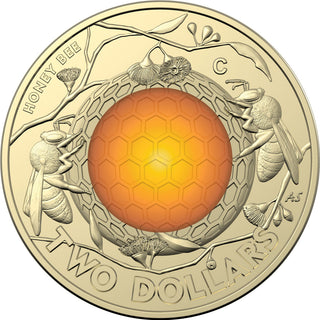2022 Australian Honey Bees $2 C Mintmark Coloured
The Royal Australian Mint and the Australian Honey Bee Industry Council proudly present this delightful coin, honouring the small yet mighty honey bee and Australia’s honey bee industry. 2022 marks the bicentenary of the establishment of the industry. The coin’s striking design and colour make it an attractive addition to collections.
Introduced in 1822, the European honey bee successfully adapted to Australia’s climate and flora; making them responsible for producing the majority of Australian honey. While there are more than 1,500 species of native honeybees, they tend to produce a lot less honey than introduced species.
Despite their small size and short lifespan, honey bees not only produce delicious honey, they are also regarded as a valuable agricultural commodity by providing free pollination services; resulting in superior quality harvest and increased yield. Honey bee pollination is estimated to contribute $4 to $6 billion to the economy.
Across Australia, there are approximately 20,000 registered beekeepers who operate more than 640,000 hives, producing up to 30,000 tonnes of honey each year. This honey is consumed in nearly 40 countries across the globe, including Canada, China, Malaysia, Singapore, the United Kingdom and, of course, Australia.
2022 Australian Honey Bees $2 C Mintmark Coloured
The Royal Australian Mint and the Australian Honey Bee Industry Council proudly present this delightful coin, honouring the small yet mighty honey bee and Australia’s honey bee industry. 2022 marks the bicentenary of the establishment of the industry. The coin’s striking design and colour make it an attractive addition to collections.
Introduced in 1822, the European honey bee successfully adapted to Australia’s climate and flora; making them responsible for producing the majority of Australian honey. While there are more than 1,500 species of native honeybees, they tend to produce a lot less honey than introduced species.
Despite their small size and short lifespan, honey bees not only produce delicious honey, they are also regarded as a valuable agricultural commodity by providing free pollination services; resulting in superior quality harvest and increased yield. Honey bee pollination is estimated to contribute $4 to $6 billion to the economy.
Across Australia, there are approximately 20,000 registered beekeepers who operate more than 640,000 hives, producing up to 30,000 tonnes of honey each year. This honey is consumed in nearly 40 countries across the globe, including Canada, China, Malaysia, Singapore, the United Kingdom and, of course, Australia.


